Agile Project Management: Scrum and Kanban Frameworks
VerifiedAdded on 2023/06/03
|17
|3094
|51
AI Summary
This report provides information about the agile project management methods like scrum and kanban frameworks, their contrasts with traditional project management, and their applicability in software development and other projects. It discusses the breakdown of big projects into small functions, continuous deployment and integration, and estimation practices. The report also highlights the importance of client involvement, user requirements, development model, project scale, organizational structure, and testing in agile project management.
Contribute Materials
Your contribution can guide someone’s learning journey. Share your
documents today.
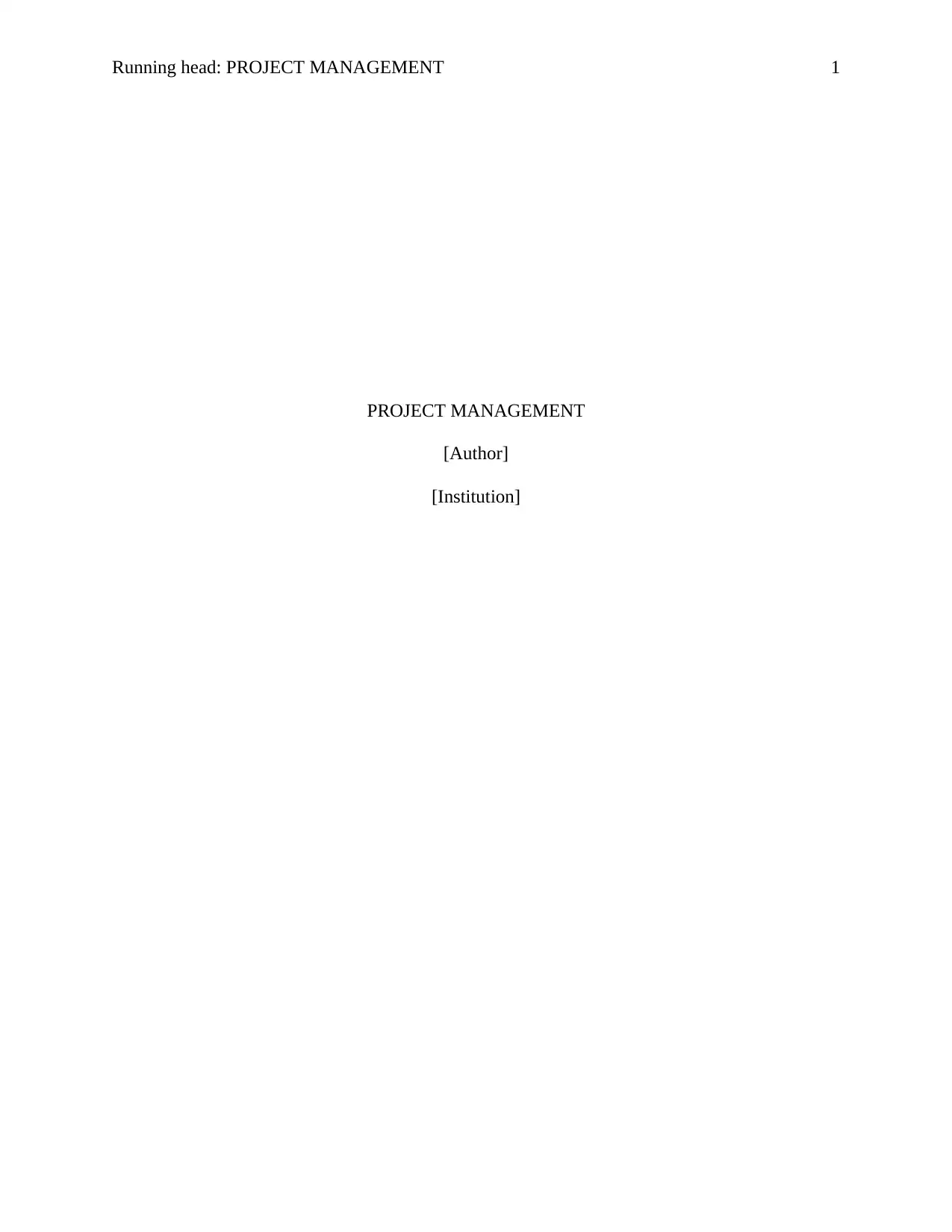
Running head: PROJECT MANAGEMENT 1
PROJECT MANAGEMENT
[Author]
[Institution]
PROJECT MANAGEMENT
[Author]
[Institution]
Secure Best Marks with AI Grader
Need help grading? Try our AI Grader for instant feedback on your assignments.
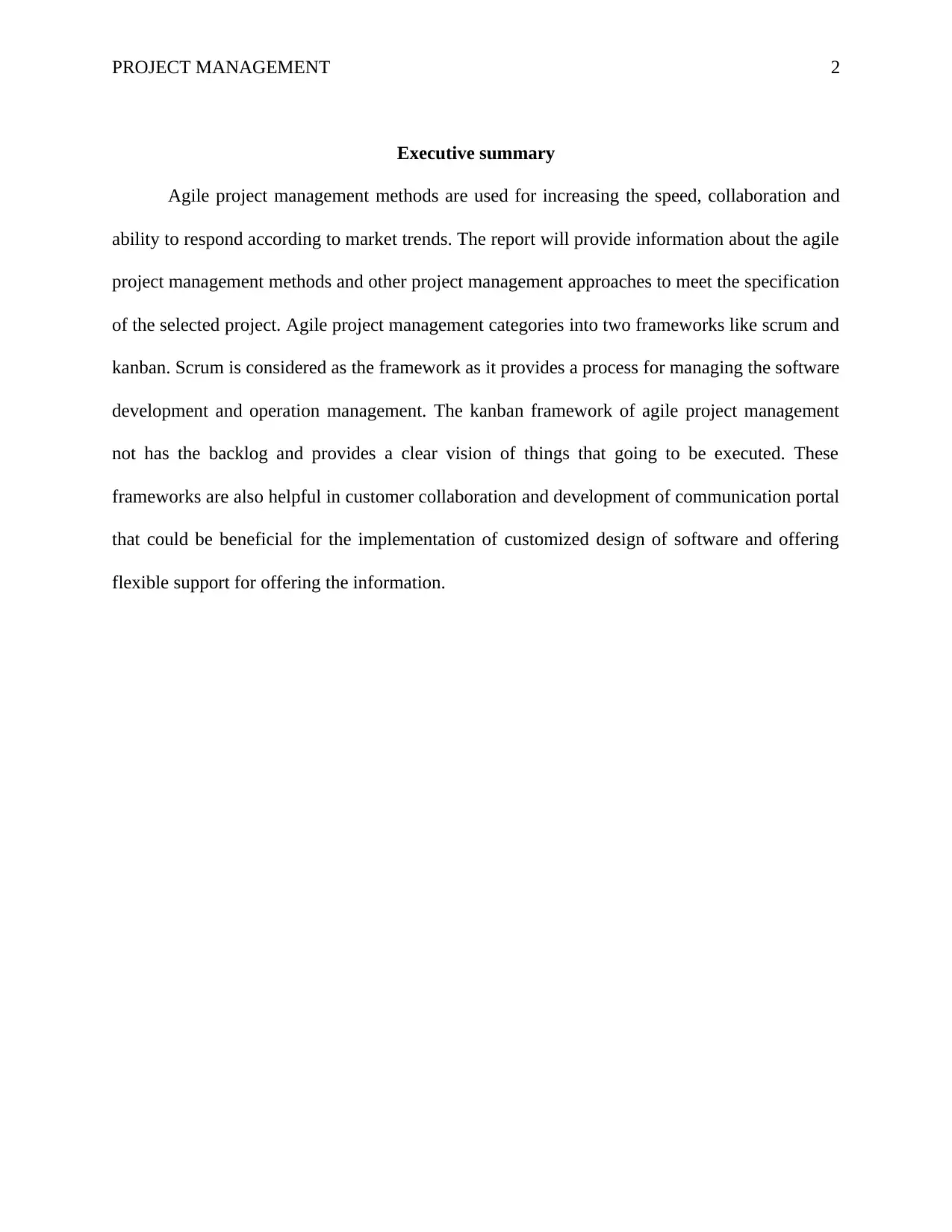
PROJECT MANAGEMENT 2
Executive summary
Agile project management methods are used for increasing the speed, collaboration and
ability to respond according to market trends. The report will provide information about the agile
project management methods and other project management approaches to meet the specification
of the selected project. Agile project management categories into two frameworks like scrum and
kanban. Scrum is considered as the framework as it provides a process for managing the software
development and operation management. The kanban framework of agile project management
not has the backlog and provides a clear vision of things that going to be executed. These
frameworks are also helpful in customer collaboration and development of communication portal
that could be beneficial for the implementation of customized design of software and offering
flexible support for offering the information.
Executive summary
Agile project management methods are used for increasing the speed, collaboration and
ability to respond according to market trends. The report will provide information about the agile
project management methods and other project management approaches to meet the specification
of the selected project. Agile project management categories into two frameworks like scrum and
kanban. Scrum is considered as the framework as it provides a process for managing the software
development and operation management. The kanban framework of agile project management
not has the backlog and provides a clear vision of things that going to be executed. These
frameworks are also helpful in customer collaboration and development of communication portal
that could be beneficial for the implementation of customized design of software and offering
flexible support for offering the information.
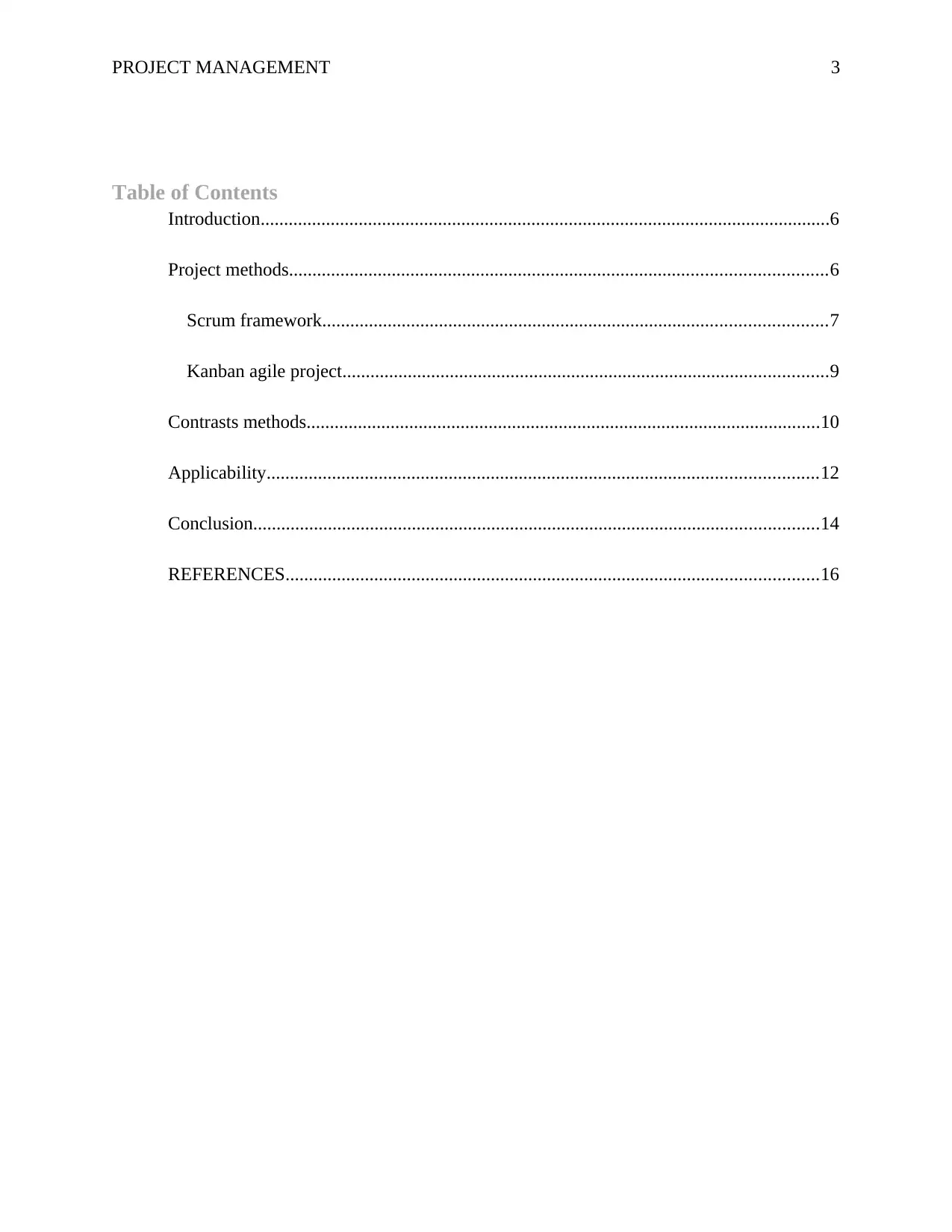
PROJECT MANAGEMENT 3
Table of Contents
Introduction..........................................................................................................................6
Project methods...................................................................................................................6
Scrum framework............................................................................................................7
Kanban agile project........................................................................................................9
Contrasts methods..............................................................................................................10
Applicability......................................................................................................................12
Conclusion.........................................................................................................................14
REFERENCES..................................................................................................................16
Table of Contents
Introduction..........................................................................................................................6
Project methods...................................................................................................................6
Scrum framework............................................................................................................7
Kanban agile project........................................................................................................9
Contrasts methods..............................................................................................................10
Applicability......................................................................................................................12
Conclusion.........................................................................................................................14
REFERENCES..................................................................................................................16
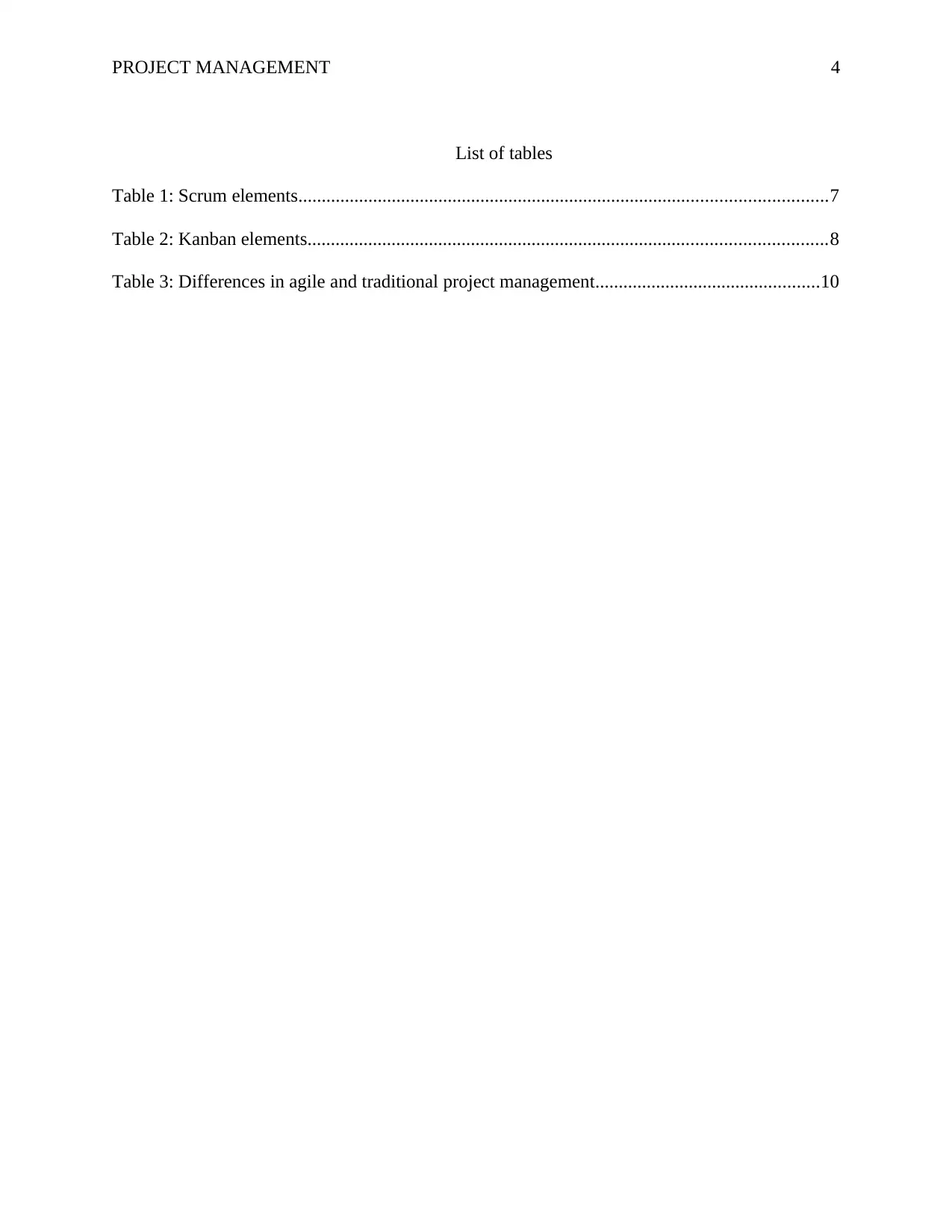
PROJECT MANAGEMENT 4
List of tables
Table 1: Scrum elements.................................................................................................................7
Table 2: Kanban elements...............................................................................................................8
Table 3: Differences in agile and traditional project management................................................10
List of tables
Table 1: Scrum elements.................................................................................................................7
Table 2: Kanban elements...............................................................................................................8
Table 3: Differences in agile and traditional project management................................................10
Secure Best Marks with AI Grader
Need help grading? Try our AI Grader for instant feedback on your assignments.
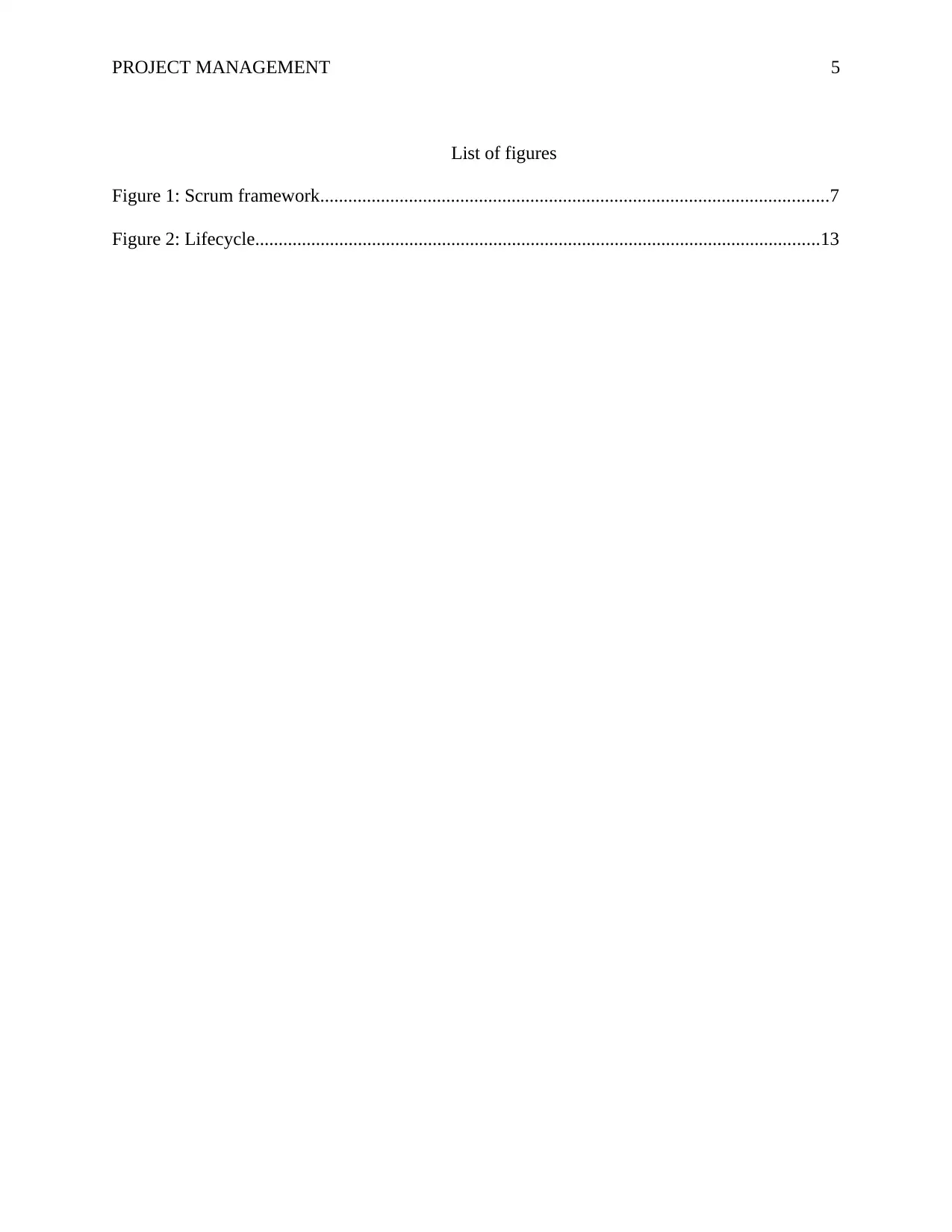
PROJECT MANAGEMENT 5
List of figures
Figure 1: Scrum framework.............................................................................................................7
Figure 2: Lifecycle.........................................................................................................................13
List of figures
Figure 1: Scrum framework.............................................................................................................7
Figure 2: Lifecycle.........................................................................................................................13
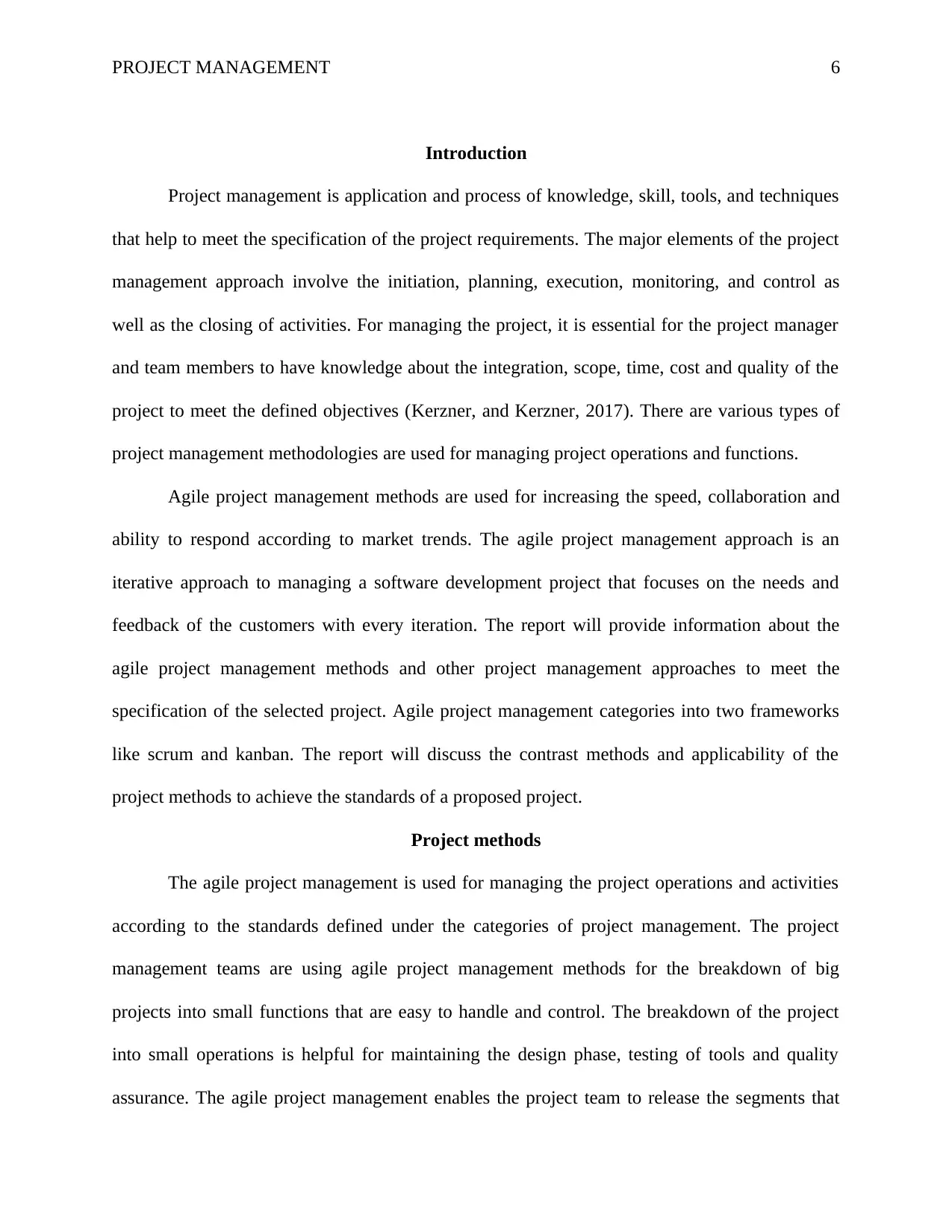
PROJECT MANAGEMENT 6
Introduction
Project management is application and process of knowledge, skill, tools, and techniques
that help to meet the specification of the project requirements. The major elements of the project
management approach involve the initiation, planning, execution, monitoring, and control as
well as the closing of activities. For managing the project, it is essential for the project manager
and team members to have knowledge about the integration, scope, time, cost and quality of the
project to meet the defined objectives (Kerzner, and Kerzner, 2017). There are various types of
project management methodologies are used for managing project operations and functions.
Agile project management methods are used for increasing the speed, collaboration and
ability to respond according to market trends. The agile project management approach is an
iterative approach to managing a software development project that focuses on the needs and
feedback of the customers with every iteration. The report will provide information about the
agile project management methods and other project management approaches to meet the
specification of the selected project. Agile project management categories into two frameworks
like scrum and kanban. The report will discuss the contrast methods and applicability of the
project methods to achieve the standards of a proposed project.
Project methods
The agile project management is used for managing the project operations and activities
according to the standards defined under the categories of project management. The project
management teams are using agile project management methods for the breakdown of big
projects into small functions that are easy to handle and control. The breakdown of the project
into small operations is helpful for maintaining the design phase, testing of tools and quality
assurance. The agile project management enables the project team to release the segments that
Introduction
Project management is application and process of knowledge, skill, tools, and techniques
that help to meet the specification of the project requirements. The major elements of the project
management approach involve the initiation, planning, execution, monitoring, and control as
well as the closing of activities. For managing the project, it is essential for the project manager
and team members to have knowledge about the integration, scope, time, cost and quality of the
project to meet the defined objectives (Kerzner, and Kerzner, 2017). There are various types of
project management methodologies are used for managing project operations and functions.
Agile project management methods are used for increasing the speed, collaboration and
ability to respond according to market trends. The agile project management approach is an
iterative approach to managing a software development project that focuses on the needs and
feedback of the customers with every iteration. The report will provide information about the
agile project management methods and other project management approaches to meet the
specification of the selected project. Agile project management categories into two frameworks
like scrum and kanban. The report will discuss the contrast methods and applicability of the
project methods to achieve the standards of a proposed project.
Project methods
The agile project management is used for managing the project operations and activities
according to the standards defined under the categories of project management. The project
management teams are using agile project management methods for the breakdown of big
projects into small functions that are easy to handle and control. The breakdown of the project
into small operations is helpful for maintaining the design phase, testing of tools and quality
assurance. The agile project management enables the project team to release the segments that
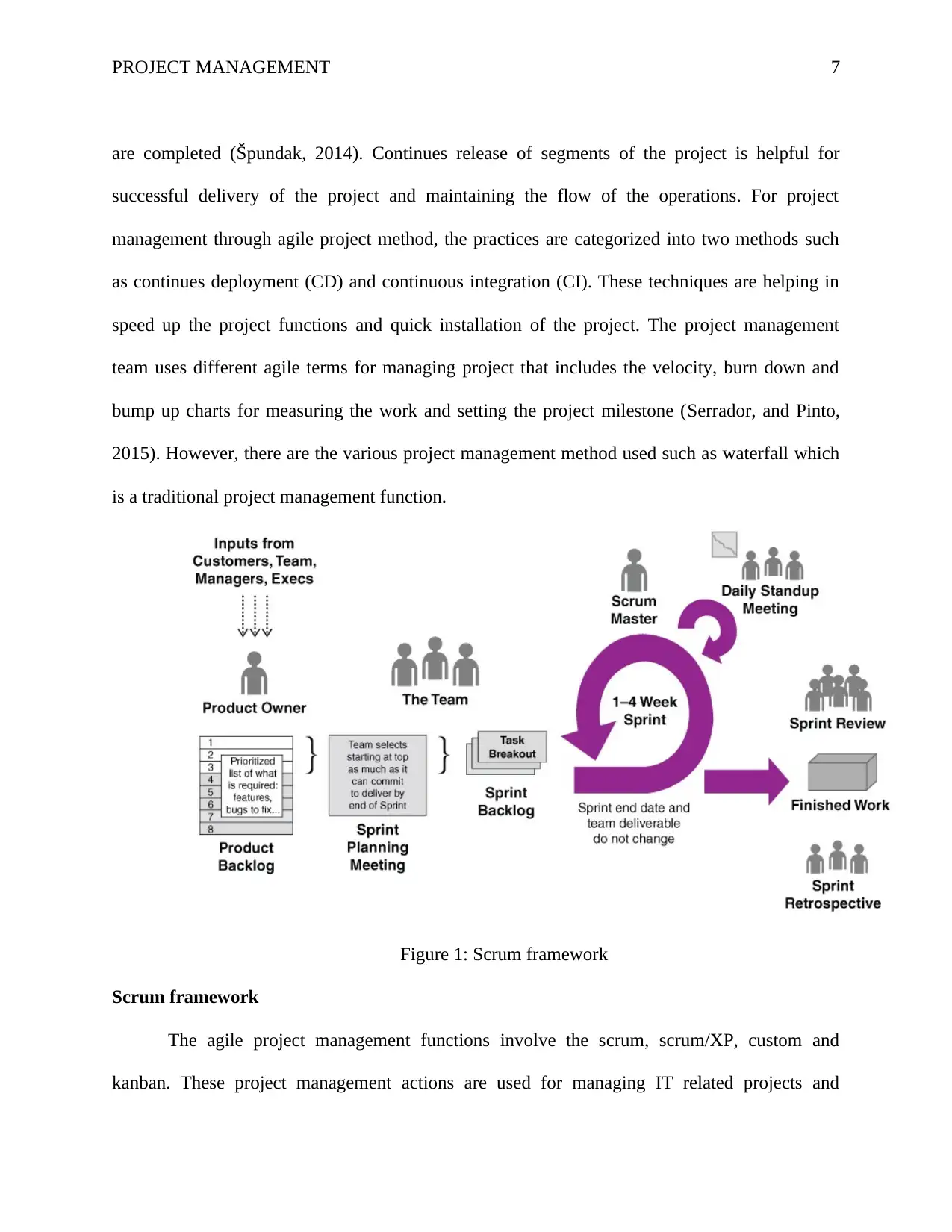
PROJECT MANAGEMENT 7
are completed (Špundak, 2014). Continues release of segments of the project is helpful for
successful delivery of the project and maintaining the flow of the operations. For project
management through agile project method, the practices are categorized into two methods such
as continues deployment (CD) and continuous integration (CI). These techniques are helping in
speed up the project functions and quick installation of the project. The project management
team uses different agile terms for managing project that includes the velocity, burn down and
bump up charts for measuring the work and setting the project milestone (Serrador, and Pinto,
2015). However, there are the various project management method used such as waterfall which
is a traditional project management function.
Figure 1: Scrum framework
Scrum framework
The agile project management functions involve the scrum, scrum/XP, custom and
kanban. These project management actions are used for managing IT related projects and
are completed (Špundak, 2014). Continues release of segments of the project is helpful for
successful delivery of the project and maintaining the flow of the operations. For project
management through agile project method, the practices are categorized into two methods such
as continues deployment (CD) and continuous integration (CI). These techniques are helping in
speed up the project functions and quick installation of the project. The project management
team uses different agile terms for managing project that includes the velocity, burn down and
bump up charts for measuring the work and setting the project milestone (Serrador, and Pinto,
2015). However, there are the various project management method used such as waterfall which
is a traditional project management function.
Figure 1: Scrum framework
Scrum framework
The agile project management functions involve the scrum, scrum/XP, custom and
kanban. These project management actions are used for managing IT related projects and
Paraphrase This Document
Need a fresh take? Get an instant paraphrase of this document with our AI Paraphraser
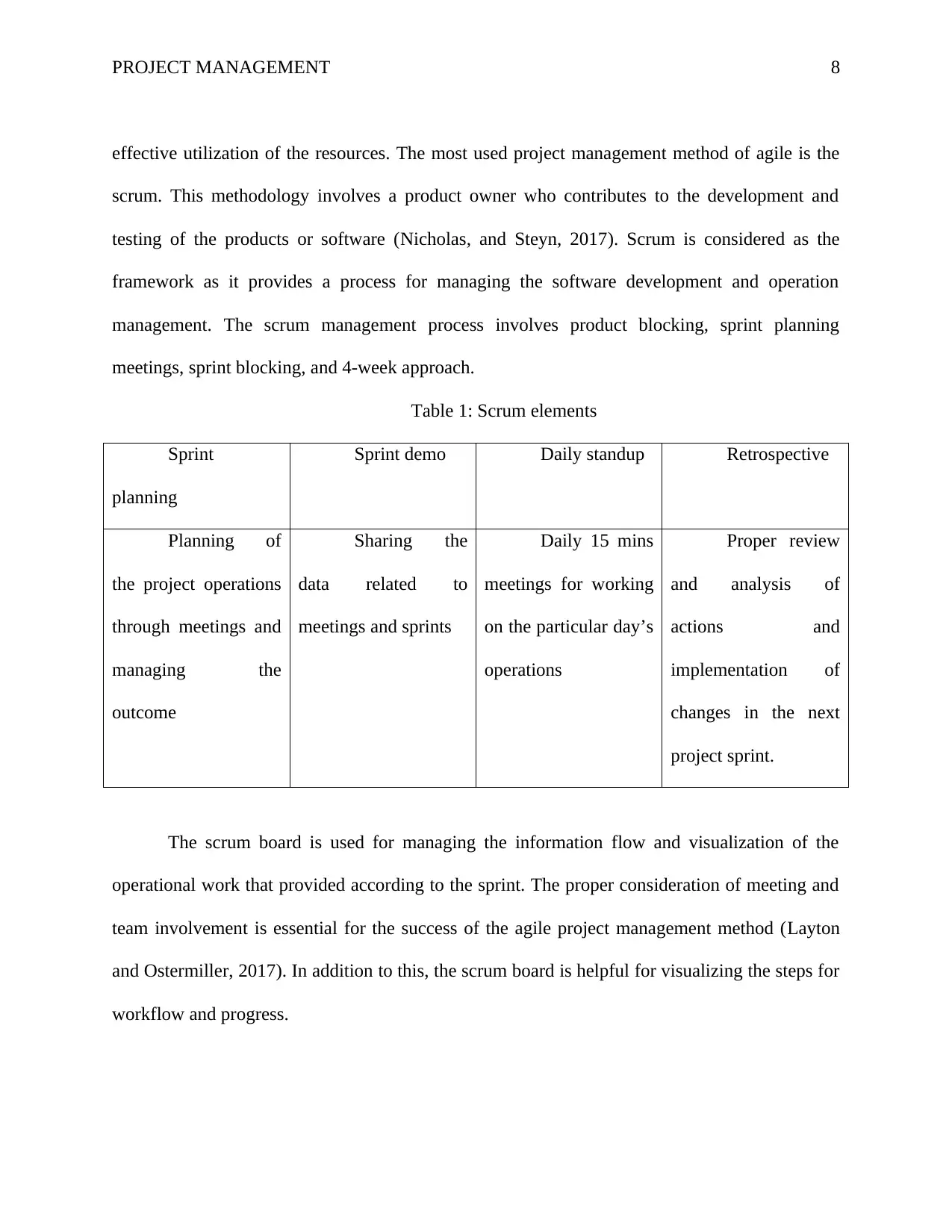
PROJECT MANAGEMENT 8
effective utilization of the resources. The most used project management method of agile is the
scrum. This methodology involves a product owner who contributes to the development and
testing of the products or software (Nicholas, and Steyn, 2017). Scrum is considered as the
framework as it provides a process for managing the software development and operation
management. The scrum management process involves product blocking, sprint planning
meetings, sprint blocking, and 4-week approach.
Table 1: Scrum elements
Sprint
planning
Sprint demo Daily standup Retrospective
Planning of
the project operations
through meetings and
managing the
outcome
Sharing the
data related to
meetings and sprints
Daily 15 mins
meetings for working
on the particular day’s
operations
Proper review
and analysis of
actions and
implementation of
changes in the next
project sprint.
The scrum board is used for managing the information flow and visualization of the
operational work that provided according to the sprint. The proper consideration of meeting and
team involvement is essential for the success of the agile project management method (Layton
and Ostermiller, 2017). In addition to this, the scrum board is helpful for visualizing the steps for
workflow and progress.
effective utilization of the resources. The most used project management method of agile is the
scrum. This methodology involves a product owner who contributes to the development and
testing of the products or software (Nicholas, and Steyn, 2017). Scrum is considered as the
framework as it provides a process for managing the software development and operation
management. The scrum management process involves product blocking, sprint planning
meetings, sprint blocking, and 4-week approach.
Table 1: Scrum elements
Sprint
planning
Sprint demo Daily standup Retrospective
Planning of
the project operations
through meetings and
managing the
outcome
Sharing the
data related to
meetings and sprints
Daily 15 mins
meetings for working
on the particular day’s
operations
Proper review
and analysis of
actions and
implementation of
changes in the next
project sprint.
The scrum board is used for managing the information flow and visualization of the
operational work that provided according to the sprint. The proper consideration of meeting and
team involvement is essential for the success of the agile project management method (Layton
and Ostermiller, 2017). In addition to this, the scrum board is helpful for visualizing the steps for
workflow and progress.
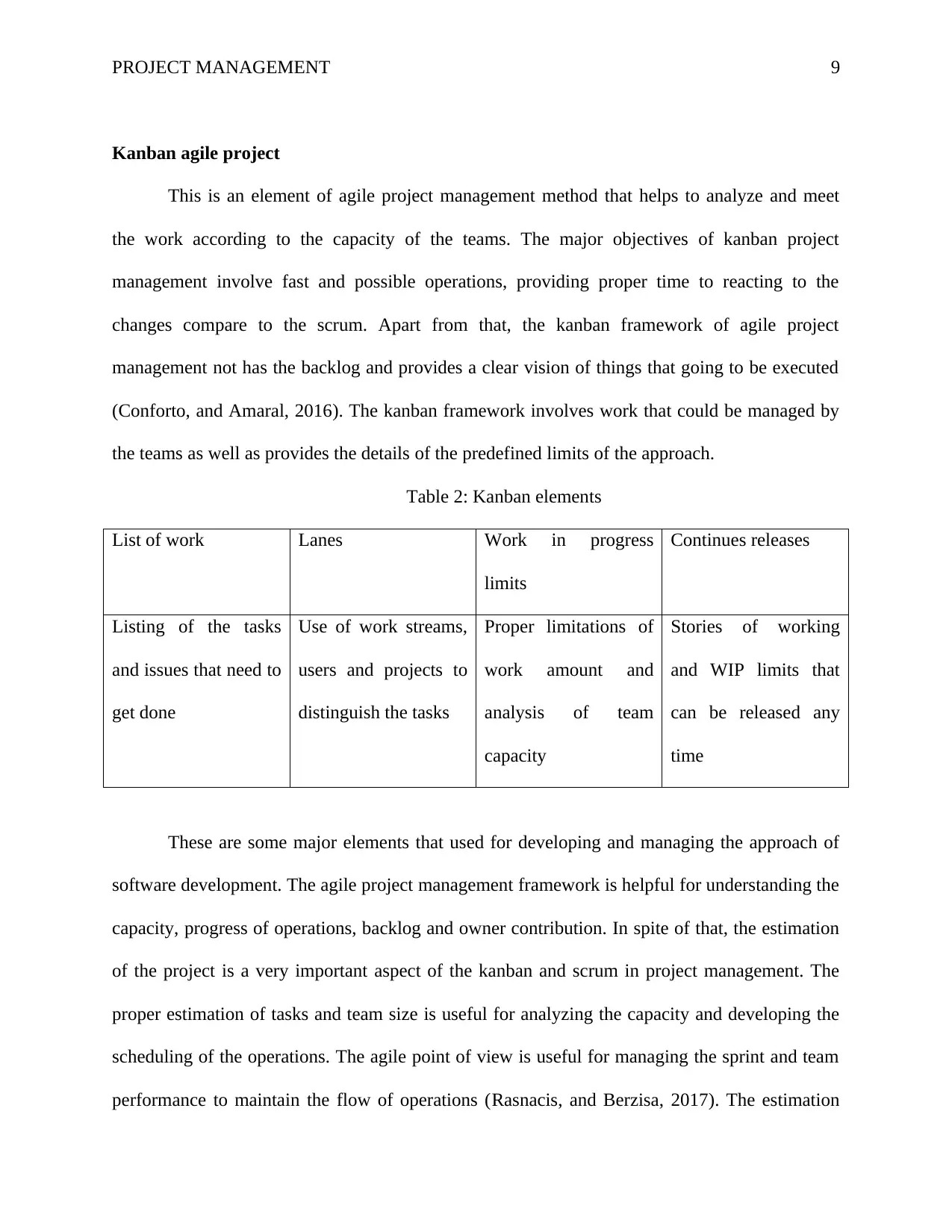
PROJECT MANAGEMENT 9
Kanban agile project
This is an element of agile project management method that helps to analyze and meet
the work according to the capacity of the teams. The major objectives of kanban project
management involve fast and possible operations, providing proper time to reacting to the
changes compare to the scrum. Apart from that, the kanban framework of agile project
management not has the backlog and provides a clear vision of things that going to be executed
(Conforto, and Amaral, 2016). The kanban framework involves work that could be managed by
the teams as well as provides the details of the predefined limits of the approach.
Table 2: Kanban elements
List of work Lanes Work in progress
limits
Continues releases
Listing of the tasks
and issues that need to
get done
Use of work streams,
users and projects to
distinguish the tasks
Proper limitations of
work amount and
analysis of team
capacity
Stories of working
and WIP limits that
can be released any
time
These are some major elements that used for developing and managing the approach of
software development. The agile project management framework is helpful for understanding the
capacity, progress of operations, backlog and owner contribution. In spite of that, the estimation
of the project is a very important aspect of the kanban and scrum in project management. The
proper estimation of tasks and team size is useful for analyzing the capacity and developing the
scheduling of the operations. The agile point of view is useful for managing the sprint and team
performance to maintain the flow of operations (Rasnacis, and Berzisa, 2017). The estimation
Kanban agile project
This is an element of agile project management method that helps to analyze and meet
the work according to the capacity of the teams. The major objectives of kanban project
management involve fast and possible operations, providing proper time to reacting to the
changes compare to the scrum. Apart from that, the kanban framework of agile project
management not has the backlog and provides a clear vision of things that going to be executed
(Conforto, and Amaral, 2016). The kanban framework involves work that could be managed by
the teams as well as provides the details of the predefined limits of the approach.
Table 2: Kanban elements
List of work Lanes Work in progress
limits
Continues releases
Listing of the tasks
and issues that need to
get done
Use of work streams,
users and projects to
distinguish the tasks
Proper limitations of
work amount and
analysis of team
capacity
Stories of working
and WIP limits that
can be released any
time
These are some major elements that used for developing and managing the approach of
software development. The agile project management framework is helpful for understanding the
capacity, progress of operations, backlog and owner contribution. In spite of that, the estimation
of the project is a very important aspect of the kanban and scrum in project management. The
proper estimation of tasks and team size is useful for analyzing the capacity and developing the
scheduling of the operations. The agile point of view is useful for managing the sprint and team
performance to maintain the flow of operations (Rasnacis, and Berzisa, 2017). The estimation
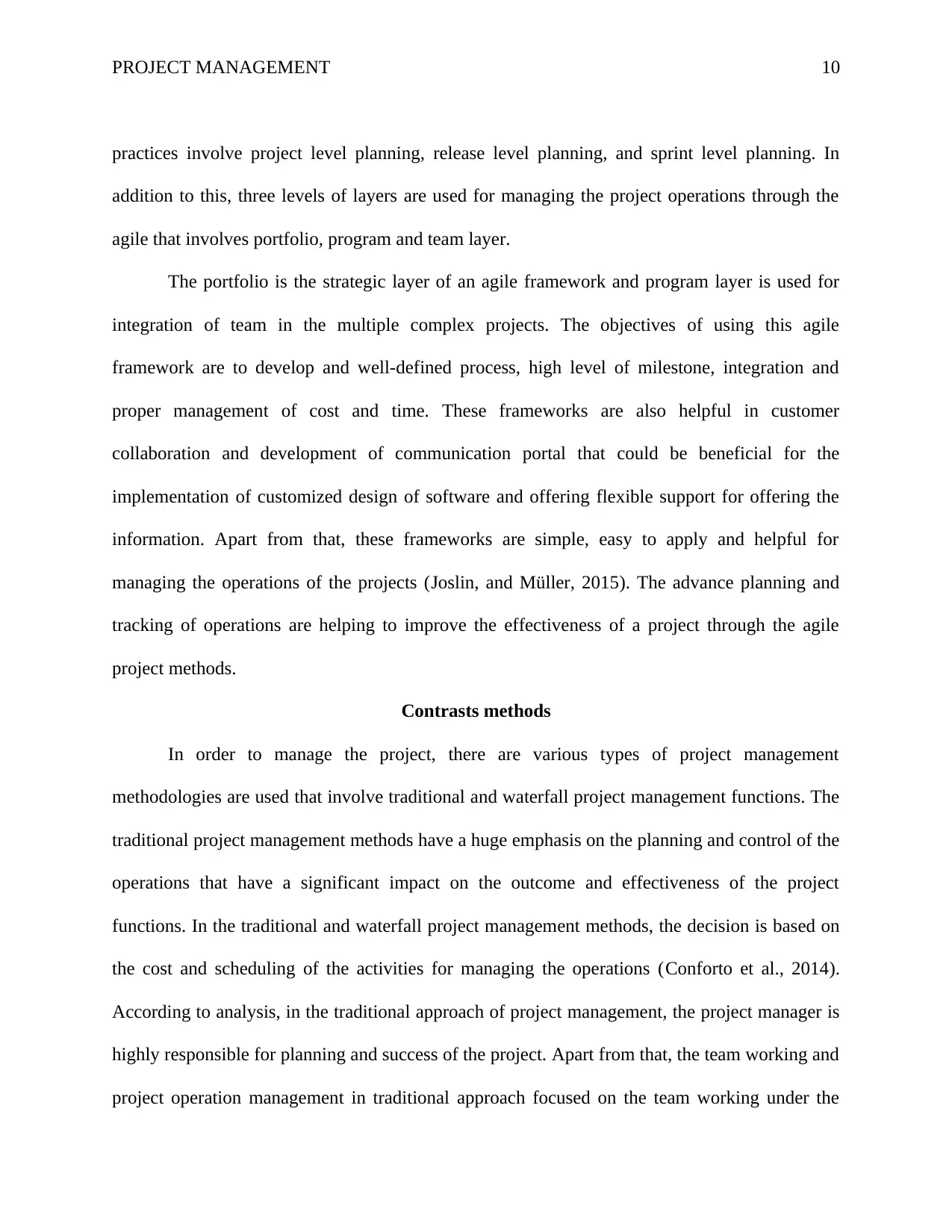
PROJECT MANAGEMENT 10
practices involve project level planning, release level planning, and sprint level planning. In
addition to this, three levels of layers are used for managing the project operations through the
agile that involves portfolio, program and team layer.
The portfolio is the strategic layer of an agile framework and program layer is used for
integration of team in the multiple complex projects. The objectives of using this agile
framework are to develop and well-defined process, high level of milestone, integration and
proper management of cost and time. These frameworks are also helpful in customer
collaboration and development of communication portal that could be beneficial for the
implementation of customized design of software and offering flexible support for offering the
information. Apart from that, these frameworks are simple, easy to apply and helpful for
managing the operations of the projects (Joslin, and Müller, 2015). The advance planning and
tracking of operations are helping to improve the effectiveness of a project through the agile
project methods.
Contrasts methods
In order to manage the project, there are various types of project management
methodologies are used that involve traditional and waterfall project management functions. The
traditional project management methods have a huge emphasis on the planning and control of the
operations that have a significant impact on the outcome and effectiveness of the project
functions. In the traditional and waterfall project management methods, the decision is based on
the cost and scheduling of the activities for managing the operations (Conforto et al., 2014).
According to analysis, in the traditional approach of project management, the project manager is
highly responsible for planning and success of the project. Apart from that, the team working and
project operation management in traditional approach focused on the team working under the
practices involve project level planning, release level planning, and sprint level planning. In
addition to this, three levels of layers are used for managing the project operations through the
agile that involves portfolio, program and team layer.
The portfolio is the strategic layer of an agile framework and program layer is used for
integration of team in the multiple complex projects. The objectives of using this agile
framework are to develop and well-defined process, high level of milestone, integration and
proper management of cost and time. These frameworks are also helpful in customer
collaboration and development of communication portal that could be beneficial for the
implementation of customized design of software and offering flexible support for offering the
information. Apart from that, these frameworks are simple, easy to apply and helpful for
managing the operations of the projects (Joslin, and Müller, 2015). The advance planning and
tracking of operations are helping to improve the effectiveness of a project through the agile
project methods.
Contrasts methods
In order to manage the project, there are various types of project management
methodologies are used that involve traditional and waterfall project management functions. The
traditional project management methods have a huge emphasis on the planning and control of the
operations that have a significant impact on the outcome and effectiveness of the project
functions. In the traditional and waterfall project management methods, the decision is based on
the cost and scheduling of the activities for managing the operations (Conforto et al., 2014).
According to analysis, in the traditional approach of project management, the project manager is
highly responsible for planning and success of the project. Apart from that, the team working and
project operation management in traditional approach focused on the team working under the
Secure Best Marks with AI Grader
Need help grading? Try our AI Grader for instant feedback on your assignments.
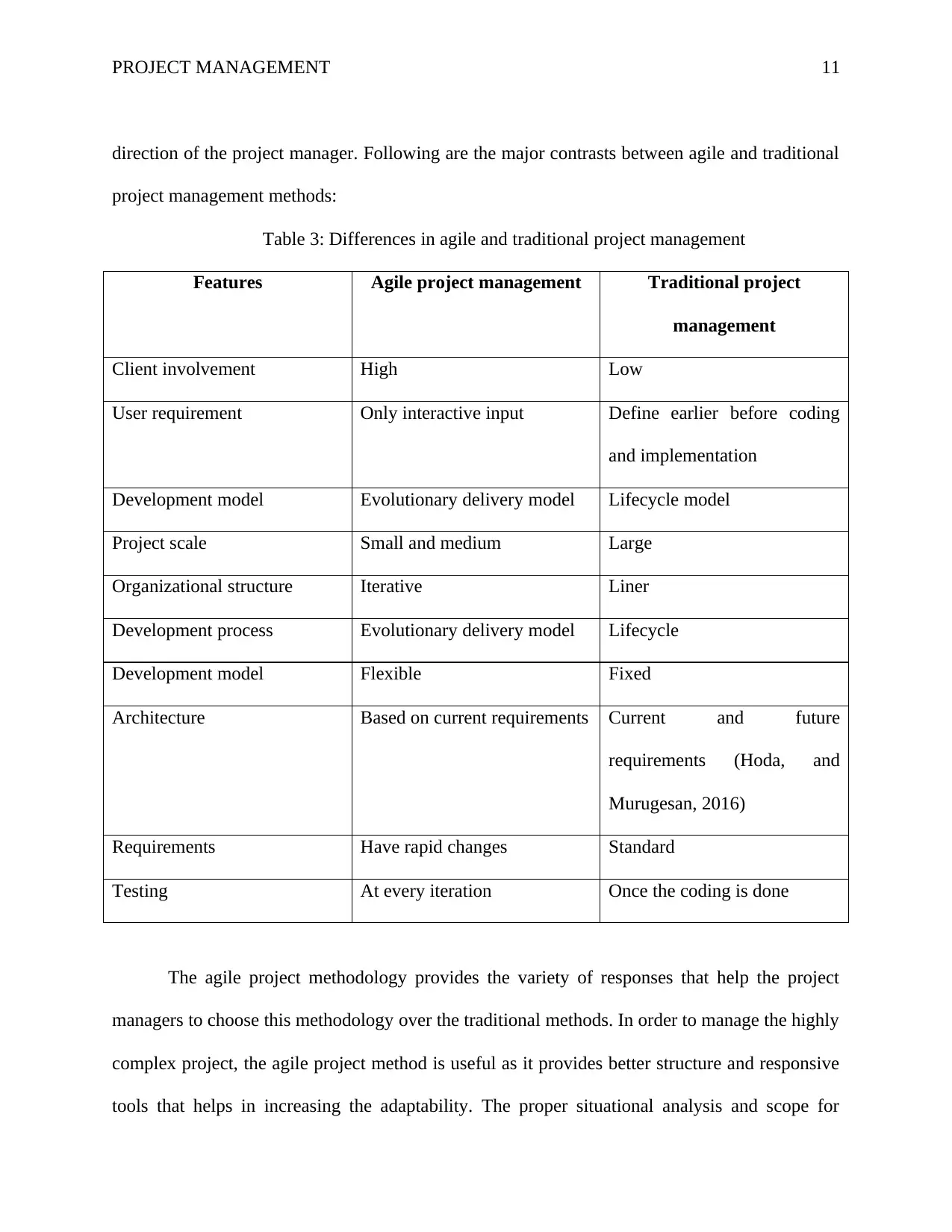
PROJECT MANAGEMENT 11
direction of the project manager. Following are the major contrasts between agile and traditional
project management methods:
Table 3: Differences in agile and traditional project management
Features Agile project management Traditional project
management
Client involvement High Low
User requirement Only interactive input Define earlier before coding
and implementation
Development model Evolutionary delivery model Lifecycle model
Project scale Small and medium Large
Organizational structure Iterative Liner
Development process Evolutionary delivery model Lifecycle
Development model Flexible Fixed
Architecture Based on current requirements Current and future
requirements (Hoda, and
Murugesan, 2016)
Requirements Have rapid changes Standard
Testing At every iteration Once the coding is done
The agile project methodology provides the variety of responses that help the project
managers to choose this methodology over the traditional methods. In order to manage the highly
complex project, the agile project method is useful as it provides better structure and responsive
tools that helps in increasing the adaptability. The proper situational analysis and scope for
direction of the project manager. Following are the major contrasts between agile and traditional
project management methods:
Table 3: Differences in agile and traditional project management
Features Agile project management Traditional project
management
Client involvement High Low
User requirement Only interactive input Define earlier before coding
and implementation
Development model Evolutionary delivery model Lifecycle model
Project scale Small and medium Large
Organizational structure Iterative Liner
Development process Evolutionary delivery model Lifecycle
Development model Flexible Fixed
Architecture Based on current requirements Current and future
requirements (Hoda, and
Murugesan, 2016)
Requirements Have rapid changes Standard
Testing At every iteration Once the coding is done
The agile project methodology provides the variety of responses that help the project
managers to choose this methodology over the traditional methods. In order to manage the highly
complex project, the agile project method is useful as it provides better structure and responsive
tools that helps in increasing the adaptability. The proper situational analysis and scope for
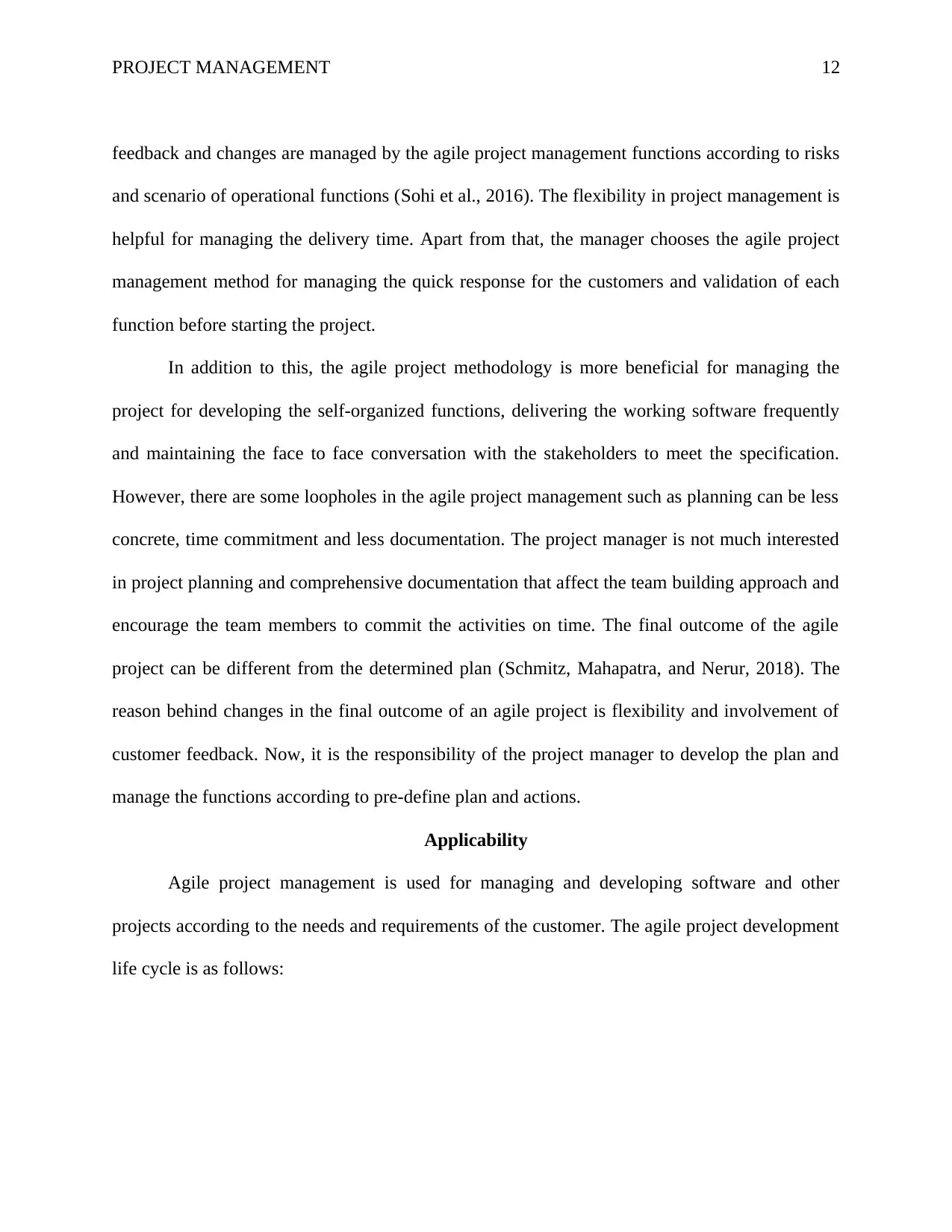
PROJECT MANAGEMENT 12
feedback and changes are managed by the agile project management functions according to risks
and scenario of operational functions (Sohi et al., 2016). The flexibility in project management is
helpful for managing the delivery time. Apart from that, the manager chooses the agile project
management method for managing the quick response for the customers and validation of each
function before starting the project.
In addition to this, the agile project methodology is more beneficial for managing the
project for developing the self-organized functions, delivering the working software frequently
and maintaining the face to face conversation with the stakeholders to meet the specification.
However, there are some loopholes in the agile project management such as planning can be less
concrete, time commitment and less documentation. The project manager is not much interested
in project planning and comprehensive documentation that affect the team building approach and
encourage the team members to commit the activities on time. The final outcome of the agile
project can be different from the determined plan (Schmitz, Mahapatra, and Nerur, 2018). The
reason behind changes in the final outcome of an agile project is flexibility and involvement of
customer feedback. Now, it is the responsibility of the project manager to develop the plan and
manage the functions according to pre-define plan and actions.
Applicability
Agile project management is used for managing and developing software and other
projects according to the needs and requirements of the customer. The agile project development
life cycle is as follows:
feedback and changes are managed by the agile project management functions according to risks
and scenario of operational functions (Sohi et al., 2016). The flexibility in project management is
helpful for managing the delivery time. Apart from that, the manager chooses the agile project
management method for managing the quick response for the customers and validation of each
function before starting the project.
In addition to this, the agile project methodology is more beneficial for managing the
project for developing the self-organized functions, delivering the working software frequently
and maintaining the face to face conversation with the stakeholders to meet the specification.
However, there are some loopholes in the agile project management such as planning can be less
concrete, time commitment and less documentation. The project manager is not much interested
in project planning and comprehensive documentation that affect the team building approach and
encourage the team members to commit the activities on time. The final outcome of the agile
project can be different from the determined plan (Schmitz, Mahapatra, and Nerur, 2018). The
reason behind changes in the final outcome of an agile project is flexibility and involvement of
customer feedback. Now, it is the responsibility of the project manager to develop the plan and
manage the functions according to pre-define plan and actions.
Applicability
Agile project management is used for managing and developing software and other
projects according to the needs and requirements of the customer. The agile project development
life cycle is as follows:
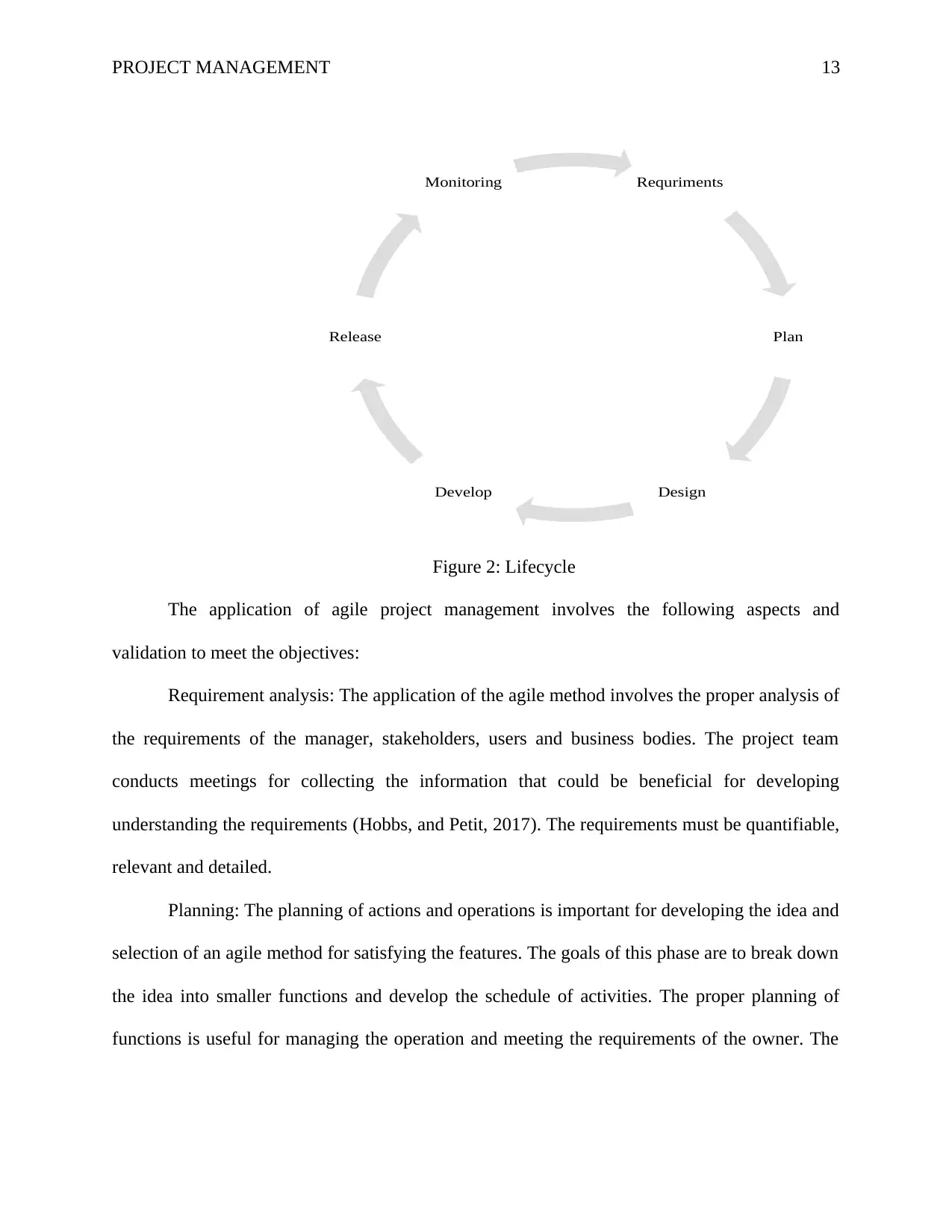
PROJECT MANAGEMENT 13
Figure 2: Lifecycle
The application of agile project management involves the following aspects and
validation to meet the objectives:
Requirement analysis: The application of the agile method involves the proper analysis of
the requirements of the manager, stakeholders, users and business bodies. The project team
conducts meetings for collecting the information that could be beneficial for developing
understanding the requirements (Hobbs, and Petit, 2017). The requirements must be quantifiable,
relevant and detailed.
Planning: The planning of actions and operations is important for developing the idea and
selection of an agile method for satisfying the features. The goals of this phase are to break down
the idea into smaller functions and develop the schedule of activities. The proper planning of
functions is useful for managing the operation and meeting the requirements of the owner. The
Requriments
Plan
DesignDevelop
Release
Monitoring
Figure 2: Lifecycle
The application of agile project management involves the following aspects and
validation to meet the objectives:
Requirement analysis: The application of the agile method involves the proper analysis of
the requirements of the manager, stakeholders, users and business bodies. The project team
conducts meetings for collecting the information that could be beneficial for developing
understanding the requirements (Hobbs, and Petit, 2017). The requirements must be quantifiable,
relevant and detailed.
Planning: The planning of actions and operations is important for developing the idea and
selection of an agile method for satisfying the features. The goals of this phase are to break down
the idea into smaller functions and develop the schedule of activities. The proper planning of
functions is useful for managing the operation and meeting the requirements of the owner. The
Requriments
Plan
DesignDevelop
Release
Monitoring
Paraphrase This Document
Need a fresh take? Get an instant paraphrase of this document with our AI Paraphraser
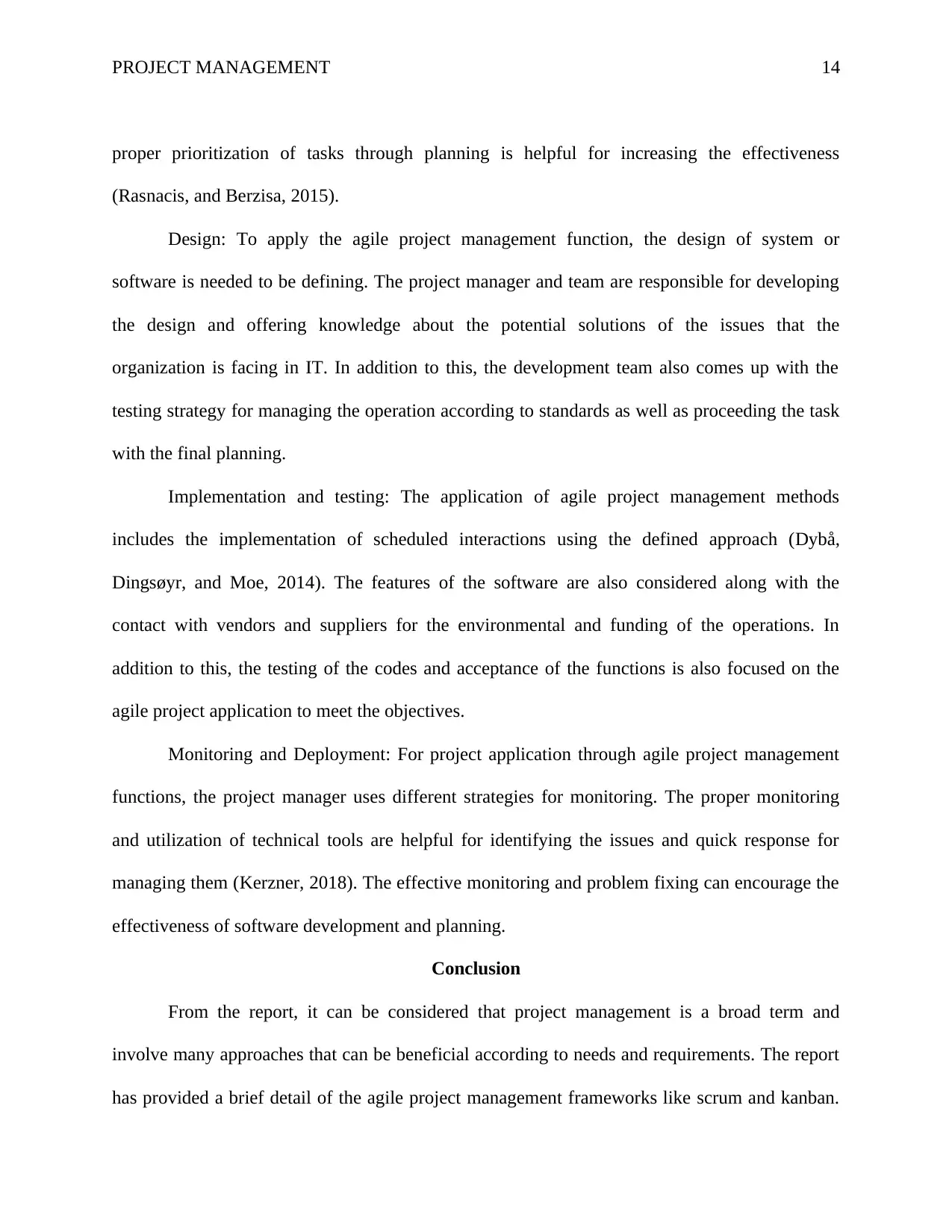
PROJECT MANAGEMENT 14
proper prioritization of tasks through planning is helpful for increasing the effectiveness
(Rasnacis, and Berzisa, 2015).
Design: To apply the agile project management function, the design of system or
software is needed to be defining. The project manager and team are responsible for developing
the design and offering knowledge about the potential solutions of the issues that the
organization is facing in IT. In addition to this, the development team also comes up with the
testing strategy for managing the operation according to standards as well as proceeding the task
with the final planning.
Implementation and testing: The application of agile project management methods
includes the implementation of scheduled interactions using the defined approach (Dybå,
Dingsøyr, and Moe, 2014). The features of the software are also considered along with the
contact with vendors and suppliers for the environmental and funding of the operations. In
addition to this, the testing of the codes and acceptance of the functions is also focused on the
agile project application to meet the objectives.
Monitoring and Deployment: For project application through agile project management
functions, the project manager uses different strategies for monitoring. The proper monitoring
and utilization of technical tools are helpful for identifying the issues and quick response for
managing them (Kerzner, 2018). The effective monitoring and problem fixing can encourage the
effectiveness of software development and planning.
Conclusion
From the report, it can be considered that project management is a broad term and
involve many approaches that can be beneficial according to needs and requirements. The report
has provided a brief detail of the agile project management frameworks like scrum and kanban.
proper prioritization of tasks through planning is helpful for increasing the effectiveness
(Rasnacis, and Berzisa, 2015).
Design: To apply the agile project management function, the design of system or
software is needed to be defining. The project manager and team are responsible for developing
the design and offering knowledge about the potential solutions of the issues that the
organization is facing in IT. In addition to this, the development team also comes up with the
testing strategy for managing the operation according to standards as well as proceeding the task
with the final planning.
Implementation and testing: The application of agile project management methods
includes the implementation of scheduled interactions using the defined approach (Dybå,
Dingsøyr, and Moe, 2014). The features of the software are also considered along with the
contact with vendors and suppliers for the environmental and funding of the operations. In
addition to this, the testing of the codes and acceptance of the functions is also focused on the
agile project application to meet the objectives.
Monitoring and Deployment: For project application through agile project management
functions, the project manager uses different strategies for monitoring. The proper monitoring
and utilization of technical tools are helpful for identifying the issues and quick response for
managing them (Kerzner, 2018). The effective monitoring and problem fixing can encourage the
effectiveness of software development and planning.
Conclusion
From the report, it can be considered that project management is a broad term and
involve many approaches that can be beneficial according to needs and requirements. The report
has provided a brief detail of the agile project management frameworks like scrum and kanban.
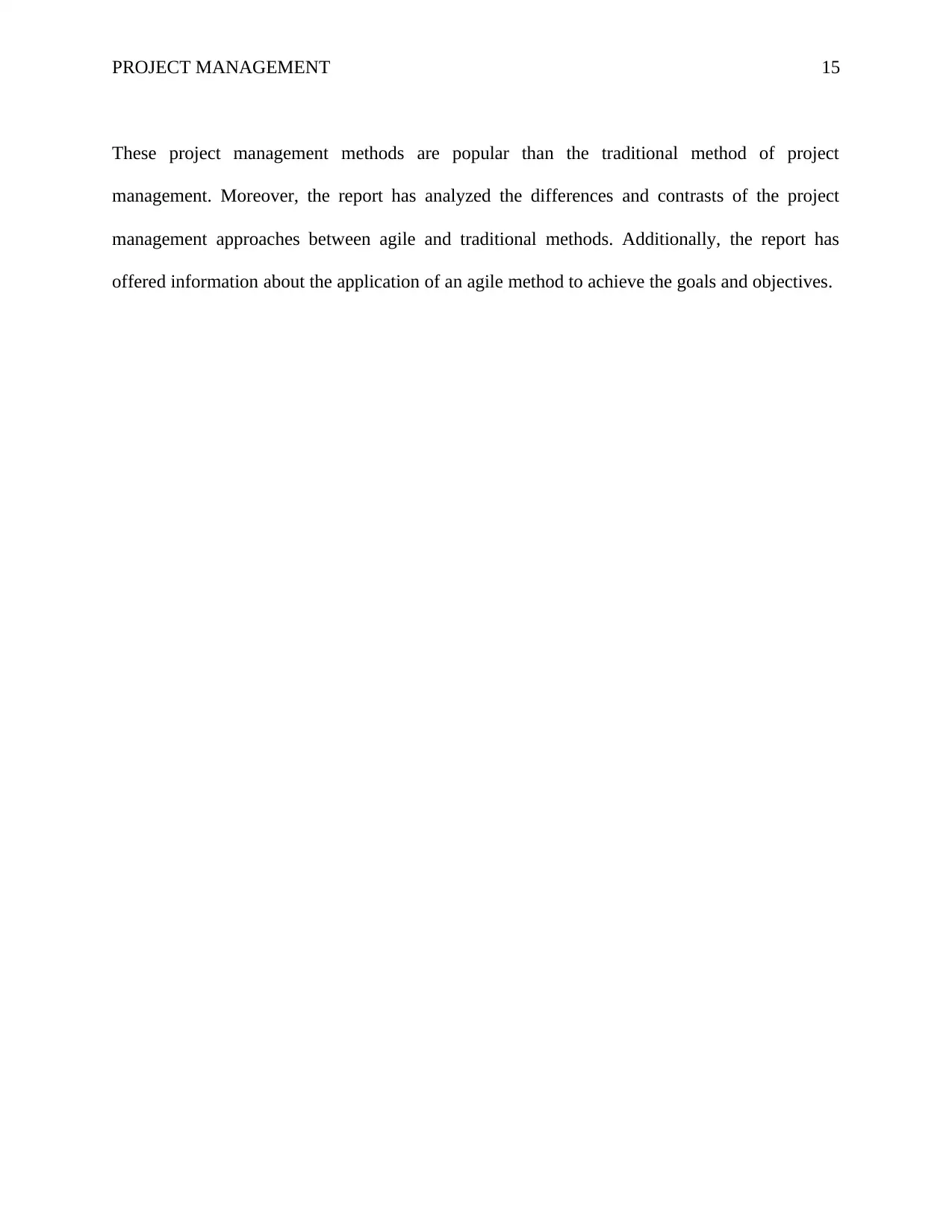
PROJECT MANAGEMENT 15
These project management methods are popular than the traditional method of project
management. Moreover, the report has analyzed the differences and contrasts of the project
management approaches between agile and traditional methods. Additionally, the report has
offered information about the application of an agile method to achieve the goals and objectives.
These project management methods are popular than the traditional method of project
management. Moreover, the report has analyzed the differences and contrasts of the project
management approaches between agile and traditional methods. Additionally, the report has
offered information about the application of an agile method to achieve the goals and objectives.
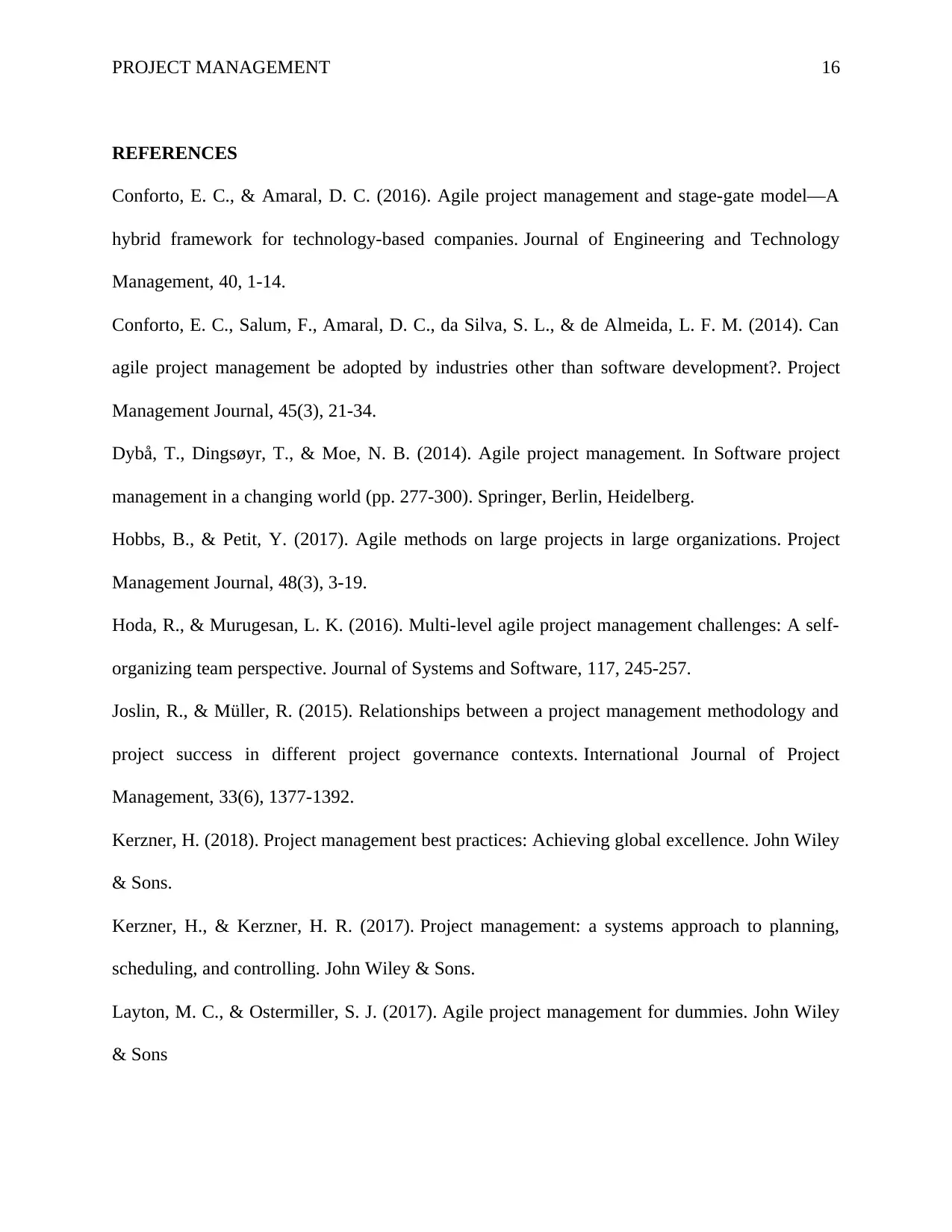
PROJECT MANAGEMENT 16
REFERENCES
Conforto, E. C., & Amaral, D. C. (2016). Agile project management and stage-gate model—A
hybrid framework for technology-based companies. Journal of Engineering and Technology
Management, 40, 1-14.
Conforto, E. C., Salum, F., Amaral, D. C., da Silva, S. L., & de Almeida, L. F. M. (2014). Can
agile project management be adopted by industries other than software development?. Project
Management Journal, 45(3), 21-34.
Dybå, T., Dingsøyr, T., & Moe, N. B. (2014). Agile project management. In Software project
management in a changing world (pp. 277-300). Springer, Berlin, Heidelberg.
Hobbs, B., & Petit, Y. (2017). Agile methods on large projects in large organizations. Project
Management Journal, 48(3), 3-19.
Hoda, R., & Murugesan, L. K. (2016). Multi-level agile project management challenges: A self-
organizing team perspective. Journal of Systems and Software, 117, 245-257.
Joslin, R., & Müller, R. (2015). Relationships between a project management methodology and
project success in different project governance contexts. International Journal of Project
Management, 33(6), 1377-1392.
Kerzner, H. (2018). Project management best practices: Achieving global excellence. John Wiley
& Sons.
Kerzner, H., & Kerzner, H. R. (2017). Project management: a systems approach to planning,
scheduling, and controlling. John Wiley & Sons.
Layton, M. C., & Ostermiller, S. J. (2017). Agile project management for dummies. John Wiley
& Sons
REFERENCES
Conforto, E. C., & Amaral, D. C. (2016). Agile project management and stage-gate model—A
hybrid framework for technology-based companies. Journal of Engineering and Technology
Management, 40, 1-14.
Conforto, E. C., Salum, F., Amaral, D. C., da Silva, S. L., & de Almeida, L. F. M. (2014). Can
agile project management be adopted by industries other than software development?. Project
Management Journal, 45(3), 21-34.
Dybå, T., Dingsøyr, T., & Moe, N. B. (2014). Agile project management. In Software project
management in a changing world (pp. 277-300). Springer, Berlin, Heidelberg.
Hobbs, B., & Petit, Y. (2017). Agile methods on large projects in large organizations. Project
Management Journal, 48(3), 3-19.
Hoda, R., & Murugesan, L. K. (2016). Multi-level agile project management challenges: A self-
organizing team perspective. Journal of Systems and Software, 117, 245-257.
Joslin, R., & Müller, R. (2015). Relationships between a project management methodology and
project success in different project governance contexts. International Journal of Project
Management, 33(6), 1377-1392.
Kerzner, H. (2018). Project management best practices: Achieving global excellence. John Wiley
& Sons.
Kerzner, H., & Kerzner, H. R. (2017). Project management: a systems approach to planning,
scheduling, and controlling. John Wiley & Sons.
Layton, M. C., & Ostermiller, S. J. (2017). Agile project management for dummies. John Wiley
& Sons
Secure Best Marks with AI Grader
Need help grading? Try our AI Grader for instant feedback on your assignments.
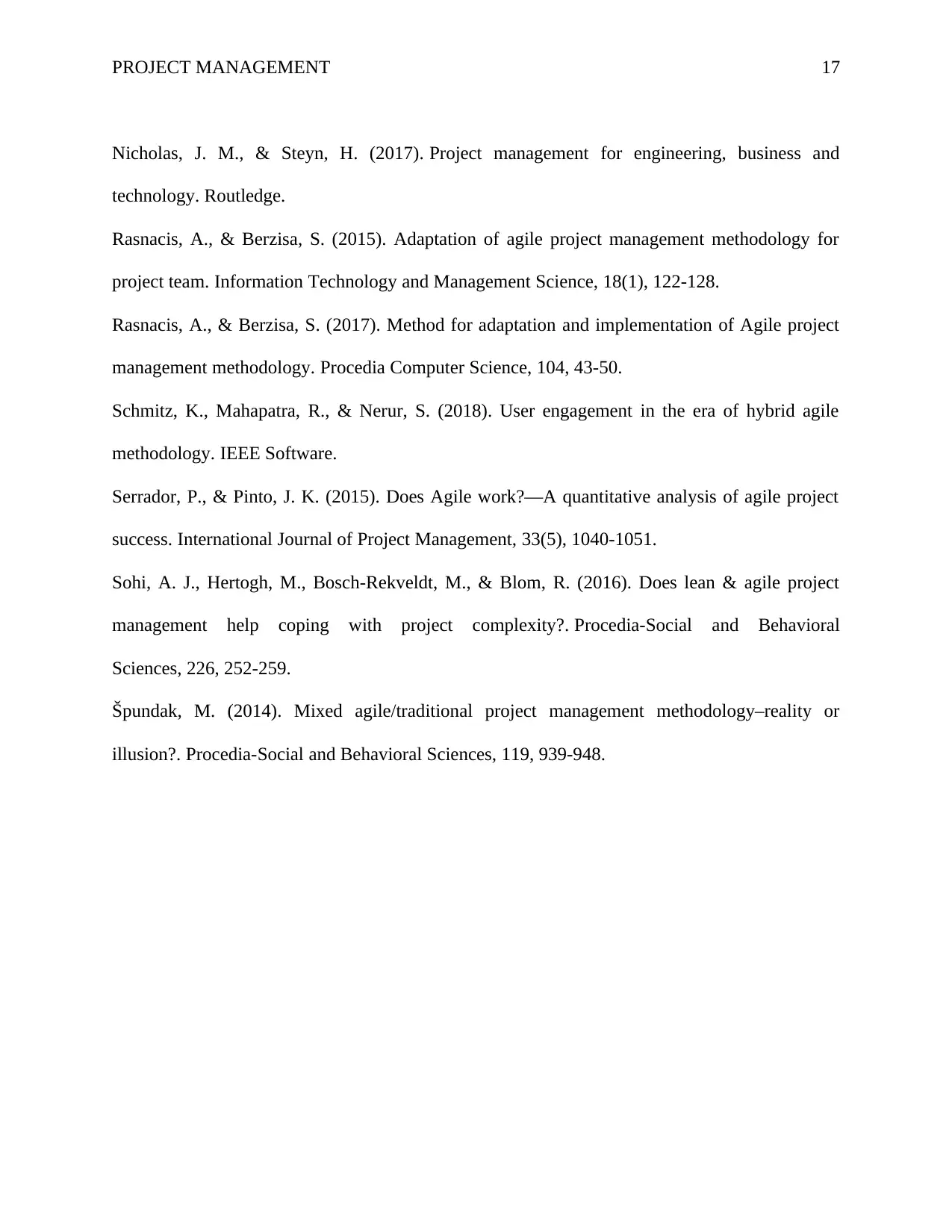
PROJECT MANAGEMENT 17
Nicholas, J. M., & Steyn, H. (2017). Project management for engineering, business and
technology. Routledge.
Rasnacis, A., & Berzisa, S. (2015). Adaptation of agile project management methodology for
project team. Information Technology and Management Science, 18(1), 122-128.
Rasnacis, A., & Berzisa, S. (2017). Method for adaptation and implementation of Agile project
management methodology. Procedia Computer Science, 104, 43-50.
Schmitz, K., Mahapatra, R., & Nerur, S. (2018). User engagement in the era of hybrid agile
methodology. IEEE Software.
Serrador, P., & Pinto, J. K. (2015). Does Agile work?—A quantitative analysis of agile project
success. International Journal of Project Management, 33(5), 1040-1051.
Sohi, A. J., Hertogh, M., Bosch-Rekveldt, M., & Blom, R. (2016). Does lean & agile project
management help coping with project complexity?. Procedia-Social and Behavioral
Sciences, 226, 252-259.
Špundak, M. (2014). Mixed agile/traditional project management methodology–reality or
illusion?. Procedia-Social and Behavioral Sciences, 119, 939-948.
Nicholas, J. M., & Steyn, H. (2017). Project management for engineering, business and
technology. Routledge.
Rasnacis, A., & Berzisa, S. (2015). Adaptation of agile project management methodology for
project team. Information Technology and Management Science, 18(1), 122-128.
Rasnacis, A., & Berzisa, S. (2017). Method for adaptation and implementation of Agile project
management methodology. Procedia Computer Science, 104, 43-50.
Schmitz, K., Mahapatra, R., & Nerur, S. (2018). User engagement in the era of hybrid agile
methodology. IEEE Software.
Serrador, P., & Pinto, J. K. (2015). Does Agile work?—A quantitative analysis of agile project
success. International Journal of Project Management, 33(5), 1040-1051.
Sohi, A. J., Hertogh, M., Bosch-Rekveldt, M., & Blom, R. (2016). Does lean & agile project
management help coping with project complexity?. Procedia-Social and Behavioral
Sciences, 226, 252-259.
Špundak, M. (2014). Mixed agile/traditional project management methodology–reality or
illusion?. Procedia-Social and Behavioral Sciences, 119, 939-948.
1 out of 17
Related Documents
Your All-in-One AI-Powered Toolkit for Academic Success.
+13062052269
info@desklib.com
Available 24*7 on WhatsApp / Email
![[object Object]](/_next/static/media/star-bottom.7253800d.svg)
Unlock your academic potential
© 2024 | Zucol Services PVT LTD | All rights reserved.



